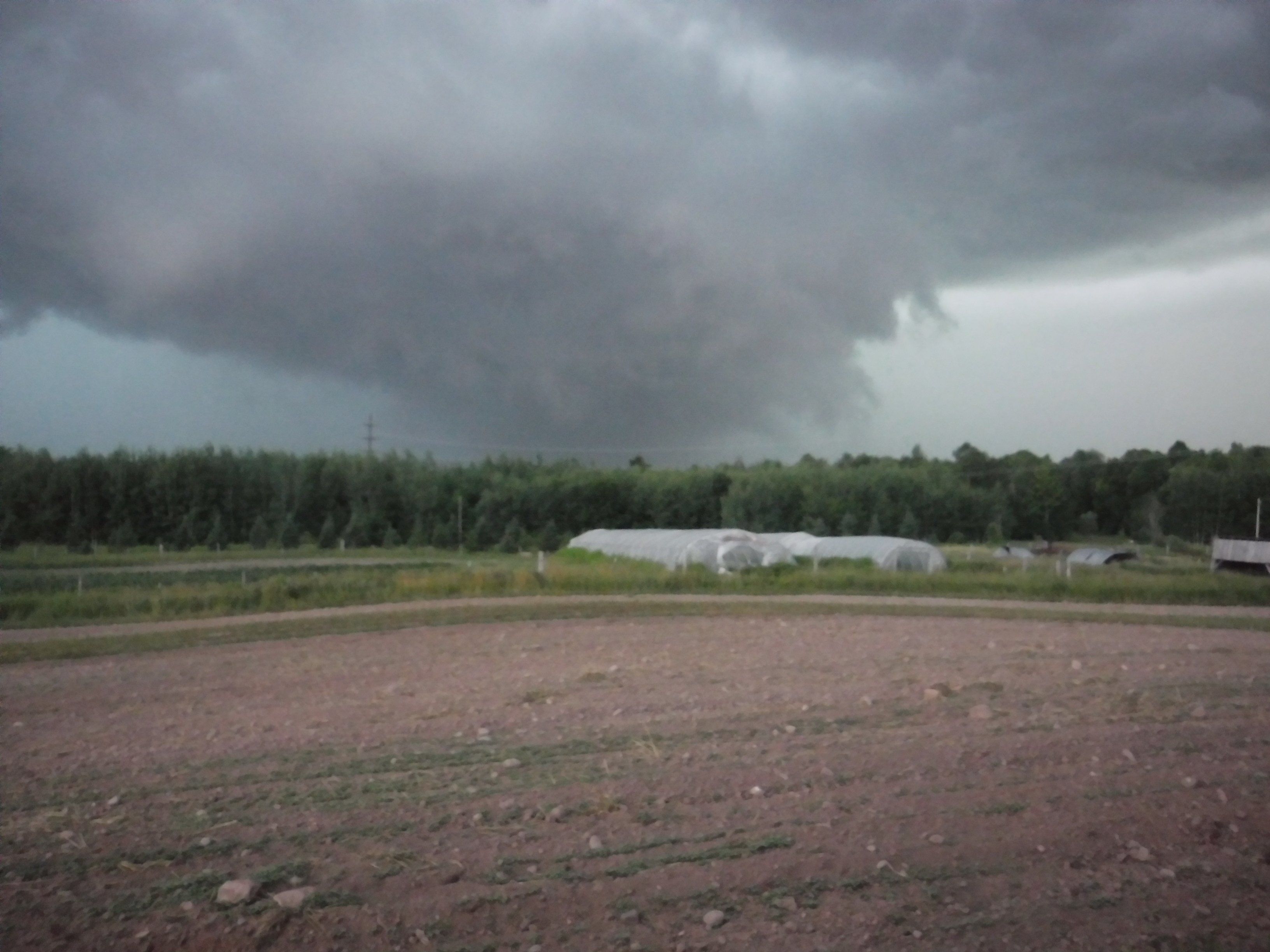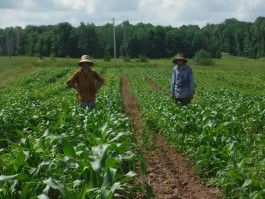Announcement for the week: The Plus items are Happy Hollow cheese AND Spirit Creek Farm lactofermented green beans!
Wow, it's been a hot one this week! The weather around the 4th of July is usually some of our hottest, and while the 90-100 degree heat makes it pretty uncomfortable to get work done, the plants are absolutely loving this weather. Despite the lack of rain, field crops like sweet corn seem to be growing inches every day, and our first planting is knee high or better already this week. Here are my fellow farmers Eric (left) and Ryan in the sweet corn, and as you can see both are outstanding in their field! (...bad farmer joke - couldn't resist....!) All joking aside, they are both great guys with a passion for farming, and I'm honored to work along side them here at Great Oak Farm.
Inside the hoophouses, the temps will be well over 100 during the sunny part of the day, so we make sure we tend those crops before 10 am so we can stay safe. The cherry tomatoes hit the rafters of the hoophouse already this week (8' high) and we're nearly finished with the next round of pruning and trellising the plants to promote air flow for disease control and encourage good fruit production. The slicing tomatoes are now beginning to ripen, so you will begin to see those as options in your veggie boxes!
This week, we also trellised the pepper hoophouse with low string to keep the plants from toppling over, they are so heavy with green pepper fruits. We were out of there by 9 am, but as you can see the heat was brutal and we had already sweated through our shirts. It amazes me that the crops inside can withstand those high temps, but the peppers are loving the heat.
We also have a few rows of green beans as an experiment in one of the hoophouses, and they are looking fantastic. The beans were started in our greenhouse and transplanted into the hoophouse nearly 2 months ago. Next week they will likely be ready to harvest. Meanwhile, our first planting of beans outside is just beginning to flower, so it will be another 10-14 days before we're starting to pick those. Once at first planting of field beans is ready to harvest, we should have a steady supply of beans all summer long until it frosts, as we've been seeding new beds of beans every week all spring. It's finally starting to taste like summer.
Here's a picture of the beans we seeded last week, up and looking great after their first cultivation! Just yesterday I seeded the last round of green beans. That planting will be ready to pick in about 60 days (early September) and should continue to produce beans until it frosts this fall. The empty looking beds to the left of the beans are beets that are juuuust germinating and will be destined for the root cellar for your winter veggie boxes. Always planning ahead!
While we've still not had much rain, the hot dry temps make for good cultivating weather. Once uprooted, weeds quickly wither and die in this kind of heat, so we've been trying to use that to our advantage. The first and second plantings of carrots have been hand weeded, and just yesterday I ran through them with the tine weeder to take out the next round of tiny weeds that are just beginning to germinate. The carrots are large enough not to be uprooted by the spring tines on this tine weeder, but as the tines rake through the top inch or so of soil they do a good job at taking out the little weeds.
Here you can see Ryan cleaning up weeds in the winter squash field on the old red Farmall Cub. Notice how the engine is offset so the driver can see the row of crops below them without the body of the tractor to block their view. Pretty handy little tractor! Lots of organic growers use black plastic to suppress weeds instead of cultivating, especially for vining crops like squash, but not us. Years ago I tried using black plastic on my winter squash for a single summer, but throwing away piles and PILES AND PILES of black plastic at the end of the season broke my heart. That winter, I sold the plastic mulch layer and never looked back. I'd rather cultivate than contribute to all that garbage.
And here's Eric heading through the broccoli and cabbage on the old orange Allis Chalmers G, our other cultivating tractor. He's using some yellow finger weeders made of flexible rubber that actually scrub out the weeds IN the row of broccoli plants (!!) as well as some more traditional sweeps that clean up the weeds between rows of plants. He's got it lifted up in this picture so you can see the cultivators - normally when in use they would be just below the surface of the soil. We had an explosion of lambsquarters (an edible weed in fact, but not the broccoli we are hoping to harvest from that field!) and the fingers did a good job at cleaning it out of the field. Can you see the 2 rows of little broccoli plants in the bed Eric is cultivating? He'll cultivate one row at a time to make sure he can keep the fingers adjusted properly, heading up one side of the bed and then back down the other side. While making 2 passes on each bed seems slow, it's light years faster than hoeing all those weeds in the row by hand, and those fingers are a great tool to have in our arsenal of organic weed control options. You may recall that John at Yoman Farm also has an Allis G, shown last week planting potatoes in the newsletter. It's another sought after little tractor used by many organic farmers. It's unique in that the engine is behind the seat, so that the driver can see the entire bed in front of them as they are cultivating.

It's hard to find the old late 40's to 1950's cultivating tractors these days. As herbicides began to emerge as "cost-effective" ways to control weeds in crops, the design of tractors changed as well. Offset tractors like the Cub or open view tractors like the G were discontinued in favor of more traditional looking tractors with motors in the front that could pull a sprayer, as the tedious and time consuming task of using steel to cultivate weeds one or two rows at a time could be replaced with simply pulling a boom sprayer along behind you to kill the weeds. Thankfully, most parts are still available for these old cultivating tractors, and while it isn't cheap they can be repaired and put back into service. It's more work to grow crops organically, but in the end I think it's a safer, more responsible way to go about producing the food we eat.
That's it for the farm report this week - back to work! Thanks for eating with us this summer, and keep your fingers crossed for rain. Have a great weekend!
In community,
Chris Duke
Farmer, Great Oak Farm










